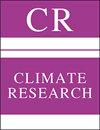恢复湖泊浮游生物群落动态变化:40年来气候变化对物候的影响
IF 1.6
4区 地球科学
Q4 ENVIRONMENTAL SCIENCES
引用次数: 5
摘要
近几十年来,全球湖泊表面温度有所上升。气候变化可以通过水温升高、冰层覆盖时间缩短和分层时间延长直接影响湖泊生物群,也可以通过物种相互作用的变化间接影响湖泊生物群。浮游植物和浮游动物的季节动态变化会进一步影响整个湖泊生态系统。然而,将气候变化的影响与营养物质更直接、更主要的影响区分开来是一项挑战。我们的目的是探索气候变化对生态的影响,同时考虑挪威最大的湖泊Mjøsa湖再贫营养化的影响。虽然自20世纪70年代以来的恢复措施导致营养水平大幅下降,但在同一时期,地表水温度上升了近0.4°C。我们分析了环境和生物时间序列的长期趋势和突变,以及浮游生物个体分类群的季节性动态变化。在物候学上,浮游植物(较晚的高峰)和浮游动物(较早的高峰)的长期趋势是不同的。然而,浮游植物和浮游动物的个体分类群都出现了较早的峰值。浮游植物类群隐藻的早期高峰可以通过春季温度升高或其他与气候相关的变化来解释。某些浮游动物物种(Limnocalanus macrurus和Holopedium gibberum)种群增长的早期开始也可以用气候变化来解释,要么是直接的(较早的温度升高),要么是间接的(较早的隐藻作为食物来源的可用性)。从长远来看,与气候相关的浮游植物和浮游动物物候变化可能对该湖的鱼类群落产生影响。本文章由计算机程序翻译,如有差异,请以英文原文为准。
Shifted dynamics of plankton communities in a restored lake: exploring the effects of climate change on phenology through four decades
Lake surface temperatures have increased globally in recent decades. Climate change can affect lake biota directly via enhanced water temperatures, shorter ice cover duration and prolonged stratification, and indirectly via changes in species interactions. Changes in the seasonal dynamics of phytoplankton and zooplankton can further affect whole lake ecosystems. However, separating the effects of climate change from the more direct and dominating effects of nutrients is a challenge. Our aim was to explore the ecological effects of climate change while accounting for the effects of re-oligotrophication in Lake Mjøsa, the largest lake in Norway. While restoration measures since the 1970s have resulted in strongly reduced nutrient levels, the surface water temperature has increased by almost 0.4°C decade-1 during the same period. We analysed long-term trends and abrupt changes in environmental and biological time series as well as changes in the seasonal dynamics of individual plankton taxa. The general long-term trends in phenology were diverging for phytoplankton (later peaks) vs. zooplankton (earlier peaks). However, individual taxa of both phytoplankton and zooplankton displayed earlier peaks. Earlier peaks of the phytoplankton group Cryptophyceae can be explained by increased spring temperature or other climate-related changes. Earlier onset of population growth of certain zooplankton species (Limnocalanus macrurus and Holopedium gibberum) can also be explained by climatic change, either directly (earlier temperature increase) or more indirectly (earlier availability of Cryptophyceae as a food source). In the long run, climate-related changes in both phytoplankton and zooplankton phenology may have implications for the fish communities of this lake.
求助全文
通过发布文献求助,成功后即可免费获取论文全文。
去求助
来源期刊

Climate Research
地学-环境科学
CiteScore
2.90
自引率
9.10%
发文量
25
审稿时长
3 months
期刊介绍:
Basic and applied research devoted to all aspects of climate – past, present and future. Investigation of the reciprocal influences between climate and organisms (including climate effects on individuals, populations, ecological communities and entire ecosystems), as well as between climate and human societies. CR invites high-quality Research Articles, Reviews, Notes and Comments/Reply Comments (see Clim Res 20:187), CR SPECIALS and Opinion Pieces. For details see the Guidelines for Authors. Papers may be concerned with:
-Interactions of climate with organisms, populations, ecosystems, and human societies
-Short- and long-term changes in climatic elements, such as humidity and precipitation, temperature, wind velocity and storms, radiation, carbon dioxide, trace gases, ozone, UV radiation
-Human reactions to climate change; health, morbidity and mortality; clothing and climate; indoor climate management
-Climate effects on biotic diversity. Paleoecology, species abundance and extinction, natural resources and water levels
-Historical case studies, including paleoecology and paleoclimatology
-Analysis of extreme climatic events, their physicochemical properties and their time–space dynamics. Climatic hazards
-Land-surface climatology. Soil degradation, deforestation, desertification
-Assessment and implementation of adaptations and response options
-Applications of climate models and modelled future climate scenarios. Methodology in model development and application
 求助内容:
求助内容: 应助结果提醒方式:
应助结果提醒方式:


